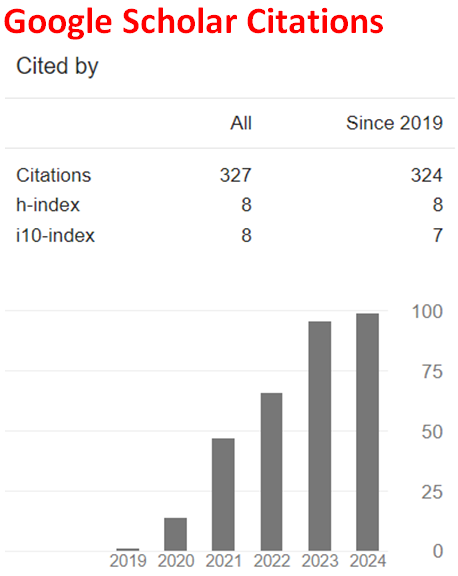Interaction of TATP with Some Group II Metals - A DFT Treatment
Abstract
Triacetonetriperoxide (TATP) is a very sensitive organic peroxide type explosive which attracts the attention of terrorist groups due to its easy synthesis. The present density functional treatment considers the interaction of TATP molecule with certain group II metals at the level of B3LYP/6-311+G(d,p). Composite systems of TATP and Be, 2Be, Mg and Ca have been considered. Although, in the case of beryllium composites TATP molecule remains intact, in its Mg and Ca composites the rupture of the ring (even in 1:1 composite) occurs. Certain structural, electronic, quantum chemical and some spectral properties of the composites have been obtained and discussed.
Downloads
References
Wolffenstein, R. (1895). Ueber die Einwirkung von Wasserstoffsuperoxyd auf Aceton und Mesityloxyd. Ber. Dtsch. Chem. Ges., 28(2), 2265-2269. https://doi.org/10.1002/cber.189502802208
Matyas, R., & Pachman, J. (2010). Study of TATP: Influence of reaction conditions on product composition. Propellants Explos. Pyrotech. 35, 31-37. https://doi.org/10.1002/prep.200800044
Jiang, H., Chu, G., Gong, H., & Qiao, Q. (1999). Tin chloride catalyzed oxidation of acetone with hydrogen peroxide to tetrameric acetone peroxide. J. Chem. Res., 28(4), 288-289. https://doi.org/10.1039/A809955C
Stiasny, B.W. (2016). Investigation of organic peroxides and their properties as energetic materials. Ph.D. Dissertation. Ludwig Maximilian University of Munich. Munich, Germany.
Bulatov, V., Reany, O., Grinko, R., Schechter, I., & Keinan, E. (2013). Time-resolved, laser initiated detonation of TATP supports the previously predicted non-redox mechanism, Phys. Chem. Chem. Phys., 15, 6041-6048. https://doi.org/10.1039/c3cp44662j
Bali, M.S., Wallace, L., Day, A.I., & Armitt, D. (2014). Cyclic pentanone peroxide: Sensitiveness and suitability as a model for triacetone triperoxide. Journal of Forensic Sciences, 59, 936-942. https://doi.org/10.1111/1556-4029.12439
Hiyoshi, R.I., Nakamura, J., & Brill, T.B. (2007). Thermal decomposition of organic peroxides TATP and HMTD by T-Jump/FTIR spectroscopy. Propellants Explos. Pyrotech., 32(2), 127-134. https://doi.org/10.1002/prep.200700002
Sinditskii, V.P., Kolesov, V.I., Egorshev, V.Yu. Patrikeev, D.I., & Dorofeev, O.V. (2014). Thermochemistry of cyclic acetone peroxides. Thermochimica Acta, 585, 10-15. https://doi.org/10.1016/j.tca.2014.03.046
Oxley, J., Smith, J.L., Huang, J., & Luo, W. (2009). Destruction of peroxide explosives. Journal of Forensic Sciences, 54(5), 1029-1033. https://doi.org/10.1111/j.1556-4029.2009.01130.x
Oxley, J.C., Smith, J.L., & Chen, H. (2002). Decomposition of a multi-peroxidic compound: triacetone triperoxide (TATP). Propellants, Explosives, Pyrotechnics, 27, 209-216. https://doi.org/10.1002/1521-4087(200209)27:4<209::AID-PREP209>3.0.CO;2-J
Dubnikova, F., Kosloff, R., Almog, J., Zeiri, Y., Boese, R., Itzhaky, H., Alt, A., & Keinan, E. (2005). Decomposition of triacetone triperoxide is an entropic explosion. J. Am. Chem. Soc., 127(4), 1146-1159. https://doi.org/10.1021/ja0464903
Tsaplev, Y.B. (2012). Decomposition of cyclic acetone peroxides in acid media. Kinet. Catal. 53, 521-524. https://doi.org/10.1134/S0023158412050163
Stewart, J.J.P. (1989). Optimization of parameters for semi empirical methods I. J. Comput. Chem. 10, 209-220. https://doi.org/10.1002/jcc.540100208
Stewart, J.J.P. (1989). Optimization of parameters for semi empirical methods II. J. Comput. Chem. 10, 221-264. https://doi.org/10.1002/jcc.540100209
Leach, A.R. (1997). Molecular Modeling. Essex: Longman.
Kohn, W., & Sham, L.J. (1965). Self-consistent equations including exchange and correlation effects. Phys. Rev., 140, 1133-1138. https://doi.org/10.1103/PhysRev.140.A1133
Parr, R.G., & Yang, W. (1989). Density functional theory of atoms and molecules. London: Oxford University Press.
Becke, A.D. (1988). Density-functional exchange-energy approximation with correct asymptotic behavior. Phys. Rev. A, 38, 3098-3100. https://doi.org/10.1103/PhysRevA.38.3098
Vosko, S.H., Vilk, L., & Nusair, M. (1980). Accurate spin-dependent electron liquid correlation energies for local spin density calculations: a critical analysis. Can. J. Phys., 58, 1200-1211. https://doi.org/10.1139/p80-159
Lee, C., Yang, W., & Parr, R.G. (1988). Development of the Colle-Salvetti correlation-energy formula into a functional of the electron density. Phys. Rev. B, 37, 785-789. https://doi.org/10.1103/PhysRevB.37.785
SPARTAN 06 (2006). Wavefunction Inc. Irvine CA, USA.
Stark, J.G., & Wallace, H.G. (1982). Chemistry data book. London: J. Murray.
Atkins, P., & de Paula, J. (2002). Atkins’ physical chemistry. Oxford: Oxford Press.
Streitwieser, A. (1961). Molecular orbital theory for organic chemists. New York: Wiley.
Fleming, I. (1973). Frontier orbitals and organic reactions. London: Wiley.

This work is licensed under a Creative Commons Attribution 4.0 International License.


